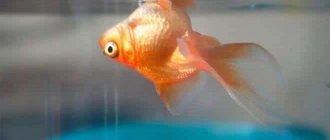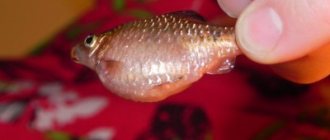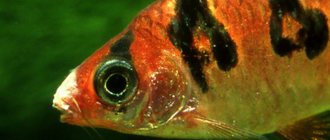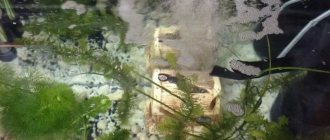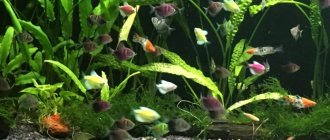Unfortunately, like other living things, fish can die before their due date. Why is this happening? Beginning aquarists often seek the answer to this question. It is much more effective to prevent the occurrence of such a problem than to later look for the reasons for the death of a pet.
An ideal option if you asked yourself this question before the tragedy occurred. Being warned means being ready to control all the nuances of the aquarium and try to avoid the early death of aquarium inhabitants. Let's look at the most common reasons.
Nitrogen poisoning
Nitrogen poisoning is the most common problem. It often concerns beginners who have no experience in dealing with aquarium animals. The fact is that they try to feed their pets to their fullest, forgetting that at the same time the amount of waste increases. According to the simplest calculations, each fish leaves excrement equal to 1/3 of its weight per day. However, not everyone knows that in the process of oxidation and decomposition, nitrogen compounds appear, consisting of:
- Ammonium,
- Nitrates,
- Nitrites.
All these substances have in common their toxicity. The most dangerous of them is considered to be ammonium, an excess of which will be the main cause of death of all inhabitants of the reservoir. This happens most often in recently launched aquariums. It is the first week after the start that becomes critical. There are two options for increasing the amount of these substances in aqua:
- Increase in the number of residents,
- Filter failure,
- Excessive amount of feed.
You can determine the excess by the state of the water, more precisely by the smell and color. If you notice darkening of the water and a rotten smell, then the process of increasing ammonium in the water has begun. It happens that upon visual inspection, the water in the fish house is crystal clear, but the smell makes you wonder. To confirm your suspicions, ask for special chemical tests at pet stores. With their help, you can easily measure the level of ammonium. True, it is worth noting the high cost of the tests, but for a novice aquarist they are very necessary if you do not want to lose all your pets in a couple of days. If the situation is corrected in time, a fatal outcome can be avoided.
How to lower ammonia levels:
- Daily ¼ water change
- The water must stand for at least a day,
- Checking the filter and filter element for serviceability.
Varieties of midges
Winter is the season of active settlement of unauthorized “tenants” into human homes. At this time, indoor plants are especially vulnerable, which is taken advantage of by dipteran parasites. How to get rid of flower flies? The question is not easy, because their population numbers hundreds of varieties. Before ridding your green pet of the threat, you need to determine the type of pest, its habits, modes of existence, and weak points. Only then will the fight against him be crowned with success.
White
Small white insects, two millimeters long, resemble aphids. Begonia, fuchsia, orchid and other soft-leaved flowering plants are their favorite habitat. Sometimes a whole cloud of two-winged midges swarms over a flower, which has three names:
- White midge.
- Shield.
- Whitefly.
Flower growers consider the whitefly the most dangerous enemy for their clients, and therefore they are constantly solving the problem of how to get rid of these flies in a flower pot.
Female white midges are very fertile, laying 300 eggs, attaching them to flower stems. Adults do not live long (a month), but midges cause significant damage to indoor plants. The scale insect feeds on leaves, under which it hides, gradually eating its “shelter”. People, without knowing it themselves, help the dipteran parasite live freely. What's in their house:
- no ventilation;
- increased moisture levels;
- too warm;
- There is almost no space between flower pots.
Frequent and abundant watering of flowers also causes harm. Houseplants can become sick and begin to infect each other. White midges willingly help them with this, flying from one pot to another.
Black
Black midges (sciarids), partial to aloe, ficus, azalea, Decembrist, orchid and other house flowers, have another name - fungus gnats. Unprepossessing in appearance, they cause quite a lot of trouble for people, constantly ending up in a cup of tea or any other drink, or in food. At the same time, they do not like human food, but end up in it solely out of their own stupidity.
Removing larvae is problematic, and therefore it is better to prevent the appearance of black parasites in your home. To do this you need:
- Do not take soil for flowers from a flower bed or garden. The soil may be contaminated. It is necessary to use the services of special stores.
- If you notice harmful insects in the substrate, you should remove the pot away from other flowers and quickly replant the plant.
- Monitor the condition of the root system; it should not rot. Decaying organic matter attracts sciarids no less than soil oversaturated with water. It is necessary to remember about moderate watering and suitable drainage.
If you are forced to replant a houseplant, you need to remove the dead roots and moisten the living ones with a weakly concentrated solution of potassium permanganate.
Earthen
Microscopic - from 1 to 4 millimeters - the creatures belong to the family of small arthropods (collembolas). They have two names: springtails and duras, in common parlance - earthen fleas. Wet substrates are places of permanent habitat. The midges are tiny, and they constantly jump, but scientists still counted them. There are more than 3,500 varieties on earth. Only a few “live” with people, living in flower pots. Characteristic features of the earthen flea:
- the body is elongated, white;
- Podura has a special jumping fork that allows her to jump;
- starts in acidified soil; its appearance in a flowerpot indicates that the root system has begun to rot;
- springtails accumulate on the surface of the soil, as well as under the flowerpot, on a wet tray;
- after abundant watering of the plant, white midges swim in the resulting puddle, bouncing dashingly on the water surface.
Ground fleas do not cause any particular trouble for flowers. But a large population can cause damage to the root systems of plants, especially young Saintpaulias and seedlings.
Incorrect launch of fish
Imagine what a fish experiences when it gets from one water to another, the parameters of which are significantly different. When you buy a fish at a pet store, you deprive it of its usual environment, transferring it to your own, which is completely unfamiliar to the fish. Water differs in hardness, temperature, acidity, etc. Of course, the reaction to such a change will be stress. A sharp change in acidity by even 1 unit means death for sensitive fish. Sometimes the difference in acidity is much greater, so the shock that the fish experiences can be fatal.
Correct adaptation of fish to a new environment:
- Pour the water along with the fish into a large vessel,
- Add some water from the general aquarium,
- After 10-15 minutes, repeat the procedure,
- Dilute the water to at least 70% solution.
Even if several new fish managed to survive after a devastating change in water parameters, they will certainly die with the first illness. The immune system is significantly weakened, which means that bacteria attack them first. Keep a close eye on aeration, cleanliness and new residents. At best, the health of the fish returns to normal.
Preventive actions
Organizing proper flower care will help avoid a lot of problems.
Removing midges is quite simple, but it is best to prevent their appearance. To prevent the appearance of pests, you must adhere to the following recommendations:
- do not overwater the plants - watering should be moderate, in winter - limited;
- monitor soil moisture - if the soil is waterlogged, the frequency of watering should be reduced;
- use a drainage layer in flowerpots - drainage prevents putrefaction of the roots and promotes uniform distribution of moisture;
- regularly loosen the soil in the pot - this procedure prevents the process of rotting roots and saturates the soil with oxygen.
Fish diseases
No one wants to blame themselves, so novice breeders blame illness for everything. Unscrupulous sellers only reinforce their doubts, since their goal is to sell expensive medicine and make money. However, do not rush for a panacea; carefully study all possible causes of death.
Diseases can only be blamed if the symptoms have been present for a long time. The fish faded away gradually, and did not just die in an instant, for no apparent reason. Most often, the disease is brought into the aquarium along with new residents or plants. Death can occur due to a malfunctioning heating element in cold weather.
When going to pet stores, you must be aware of what exactly you need medicine for. Each drug is aimed at a specific disease. There are no universal cures! If possible, consult with an experienced aquarist or on a forum; knowledgeable people will tell you what to do in such a situation.
Of course, disease cannot kill healthy fish. Why do fish die in an aquarium? If death occurs, it means that immunity has already been undermined. Most likely, the first two errors occurred. Do not rush to launch new residents, no matter how beautiful they are.
What to do to protect your aquarium:
- Organize quarantine for new residents,
- Sanitize your fish or plants.
What to do if there is a disease in the aquarium:
- Change a tenth of the water daily,
- Increase the temperature
- Increase aeration
- Remove disease carriers and those who are clearly infected.
Remember what kind of fish you launched at home last. Individuals brought from other countries can be carriers of rare diseases, which are sometimes not possible to detect and classify on their own.
Folk remedies for fighting midges in flowers
Midges have appeared in flowers - the problem arises of what means to use to rid your favorite plants of them. One of the ways to independently remove irritable insects is to use various folk remedies.
An effective folk remedy against flies is garlic. The smell of garlic has a detrimental effect on some insects, including flower midges. Just two procedures - and black midges completely die. To prepare the required solution, take three heads of garlic and chop them using a garlic press. The resulting mass is poured with one liter of boiled water. After 4 hours, strain. The leaves of the plants are sprayed with this solution and the soil in the pot is treated. You can kill midges in the soil using soap. To do this, you need to grate laundry soap (20g) and fill it with 1 liter of water. The leaves of the plant are treated with the resulting soap solution, and the soil in the pot is watered.
You can also get rid of midges using regular matches. In a pot with a flower, you should deepen about five matches of sulfur into the soil and lightly water the soil. Matches in flowers are replaced every day, as sulfur dissolves in the soil. A certain number of such procedures will rid the plant of both midges and their larvae.
Water quality
Utility services do not set themselves the task of purifying the water to such an extent that aquarium residents feel comfortable. Their goal is to make it safe for people and their homes. This is where the popularity of bottled water comes from. Tap water contains maximum levels of chlorine. In large cities, there may be a possibility of a change in water from artesian to desalinated water. As a result, water hardness will increase, which will lead to mass death. You can notice this by the changed behavior of the fish - they begin to rush around the entire aquarium in a state of horror.
How to get rid of midges using special means
You can buy them in hardware stores or departments with indoor flowers.
Sticky traps
Take fly tape or a sticky insect trap and place it near the affected plant. It will help get rid of flying individuals. This method is good if there are few insects.
Aerosols
Aerosols from flying insects will help destroy adult insects that have just appeared on plants.
When spraying them, pay special attention to shelves, racks and window sills on which potted plants stand
After treatment, carry out wet cleaning.
Mosquito fumigators
Every day, plug the device into an outlet that is located near plants affected by pests. This will repel flying midges.
Systemic insecticides
Treat the plant with an insecticide containing thiamethoxam or imidacloprid. Strictly according to the manufacturer's instructions. This will help in the fight against white and black midges, but it will not save you from fruit flies.
Remember: insects can develop immunity to a certain drug. So it is better to alternate insecticides.
O2 deficiency
This option is the rarest of all. The oxygen saturation of a fish house is always adequately assessed even by novice aquarists. The first thing everyone does is buy a compressor. With it there is no fear of fish suffocating.
The only possible option is an increase in temperature and, as a result, a decrease in oxygen in the water. This can happen at night, when plants switch from producing oxygen to absorbing it. To avoid this, do not turn off the compressor at night.
Compatibility
Compatibility with other fish is good. They can live with other representatives of their kind and even predatory catfish are not afraid of them. Although males can be aggressive among themselves. But this behavior is more often characterized by competition for the female, both in nature and in the aquarium; reproduction remains in first place. In order for the males to get along with each other, it is not necessary to place only two individuals in the reservoir; it is better to have more of them, but the number of females in the aquarium should be equal to them. They will not get along only with those aggressive and predatory waterfowl that are larger than them and can simply eat small fish. These could be cichlids, which include acara or astronotus.
Aggressive neighbors
Before you go to the store for pets, think through to the smallest detail: will several species be able to get along in one fish house? You should not count on the seller’s competence, since his main goal is to sell as much product as possible.
A few fundamental rules:
- Big fish always try to eat small ones (even in the case of herbivorous species),
- Many succumb to intraspecific aggression,
- Some know how to attach themselves to small neighbors, which ultimately turns into death,
- The strong always eat the weak
- Buy only those fish that you are sure are peaceful.
Unfortunately, it is impossible to determine why the fish are dying. The death of a pet can happen even among experienced breeders. Treat your fish carefully, and you will definitely notice a change in behavior and eliminate the cause of concern in time. More often than not, fish die in an aquarium due to oversight, and not due to other criteria.
Hello, dear friends!
Many newbie aquarium keepers very often ask why they die, although, in their opinion (I mean, in the eyes of beginners) they do everything correctly, according to the book. In this article I will try to highlight the most common mistakes that beginners make. So!
1) The first thing that beginners don’t pay attention to is the recommended water parameters! Friends! Hard and soft water are as different from each other as white and black! And if you put a fish in water that is unacceptable for it, then consider your fish dead! Therefore, I strongly recommend that you strictly follow the recommendations for maintaining water parameters!
2) The second common mistake is ignoring the water temperature. Beginners believe that a difference of one or two degrees does not play a big role for fish. How they play! Guys, fish are not people, they are so sensitive to water that you can’t even imagine! Therefore, for them, “plus” or “minus” two degrees is as noticeable as for you and me +10*C or -10*C! Keep this in mind and then you will have much less problems!
3) The third mistake is neglecting the aquarium lighting. The fact is, friends, that for most tropical fish the daylight hours last 10 - 12 hours. Our daylight hours are somewhat shorter, especially in winter. And if the fish does not receive enough light, then its biological clock will simply break. And since a fish is a fragile creature, death follows such a breakdown. Keep this in mind for the future!
4) Another reason for the frequent death of fish is the incompatibility of species. And this applies not only to carnivorous and herbivorous fish. There is also the factor of nitrogen tolerance. For example, if some fish do not react in any way to an increase in nitrogen concentration, then others die from acute nitrogen poisoning! There is only one piece of advice in this case: study the characteristics of each species before combining them in one aquarium!
5) And here is another reason - overpopulation of the aquarium! Quite often, newcomers are accommodated in one small apartment. Plus they also throw in plants the size of a cubic meter! The result is overpopulation, lack of oxygen, and - hello! Here's an unspoken rule for you, friends: at least 3 liters of water per fish! And this is for the smallest one! Depending on the size, the displacement increases. Consider this factor too!
6) Improper feeding is also a common cause of mass death of fish. For some reason, beginners think that all they have to do is throw a pinch of dry food into the aquarium and that’s it! This is absolutely wrong! Fish should eat a varied diet! And if they eat only dry food, they will very soon die from inflammation of the stomach and intestines: dry food is very difficult to digest! Diversify your fish's menu: give them dry food, live food, and plant food! For example, many fish love lettuce leaves, which need to be chopped.
Planaria, hydra and worms in aquariums
Journalist: Chezarino Date: 08/31/2009 Read: 93879 Planaria.
Size 0.3 – 1 cm. Non-parasitic flatworms. This is the only microscopic creature that, to put it mildly, I don’t like (just think about planarians - goosebumps start running down my back and my skin itches). If you “break” it into two parts while trying to remove it from the aquarium, you will end up with not one, but two planarias. Planaria come in several colors - clear, white, brown and red. In general, there is nothing terrible about them, but they can harm shrimp and snails, and they can also eat fish and snail eggs. And of course, it’s not very pleasant to look at an aquarium with whitish worms crawling on the glass. They love shrimp shed shells, pieces of meat, dead fish and shrimp, and will also eat other small creatures if they can catch them. Planaria move throughout the entire aquarium, even under a film of water. They are especially active at night. If they are frightened, they immediately curl up and shorten in size. If you have too many planarians in your aquarium, then you are overfeeding its inhabitants and/or you need to clean it.
Cyclops. Size 0.1-0.2 cm.
Cyclops are small and funny one-eyed crustaceans. They usually move across the aquarium walls and other surfaces in small jerks. They do not cause any harm, and the fish will eat them with pleasure. Cyclops come in a variety of color variations.
Daphnia. Size 0.1-0.5 cm.
Daphnia commonly serves as food for all varieties of fish. This is a type of crustacean and is easily identified by its sharp vertical movements. With which it moves through the water column. They are very useful and really, really interesting creatures.
Shell crustaceans. Size 0.1-0.2 cm.
Another very small species of crustacean. They are usually slightly larger in size than a Cyclops. They follow the same trajectory as the Cyclops and eat a lot of great food, such as deposits on glass, plants, etc. Sometimes they swim right in the water column in the most visible place, resembling drunken bees. Interesting and absolutely not dangerous. Very useful in aquariums, as they clean the substrate, penetrating deep to the bottom, and are a sign of clean water.
Nematodes. Size 0.1-0.3 cm.
]These are white or transparent, long and thin roundworms. They move through the water with movements that are similar to the English letter “S”. You can find them at the base of the aquarium in the ground, and they can also come out of the filter when you turn it on. They are not dangerous to the inhabitants of your aquarium, but their appearance indicates that you are overfeeding the fish and you should clean the aquarium. Planaria.
Acroloxus lacustris. Size 0.1-0.8 cm
This is one of the types of mollusks whose older brothers are called “lake shuttle”. They are very small in size and move very slowly, so sometimes it can be mistaken for a snail. Based on their size, they cannot cause much harm to the inhabitants of the aquarium, but they can find and eat eggs laid by snails. Their shell is hard, pale white, round or oval in shape, 1-2 mm in diameter.
Tubifex. Size 2-5 cm.
These are red juicy worms, which are also used in the form of live, frozen or freeze-dried fish food. They live in the ground. If you disturb them, they will curl up into a ring, but if you leave them in a calm state, they will lie on the water like elongated red strings. If you find too many tubifex worms in your aquarium, this is a consequence of excessive contamination of the substrate and it’s time for you to think about washing or replacing it.
Hydra. Size 0.3-1.5 cm.
The hydra itself is a rather cute, but annoying creature with its appearance. They stick to various surfaces in the aquarium and stay that way throughout their lives. They may move around a little, but usually sit still. The photo shows one of the varieties (Hydra Virridissima). If you disturb them, they retract their tentacles and curl up. With the help of tentacles that can sting, they catch various small organisms. They pose no threat to adult fish, shrimp or snails, but are quite dangerous for newborn fry or shrimp.
Briosa. A single individual is a couple of millimeters in length. But a whole colony can reach a length of 10 cm.
These are colonial creatures. They look like corals with a hard skeleton on which the colony is based. They can feed on polyplankton and zooplankton. Not dangerous, even useful.
Springtails (Collembola). Size 0.1-0.3 cm.
These are small insects that “walk” through the water column. They can serve as food for some species of fish (for example, bettas and other labyrinths). They can often be found on plants protruding from the surface of the water. If you disturb them, they will quickly jump away from you and try to hide. Helpful. Mosquitoes and mosquitoes. Bloodworm.
Satu www.planetinverts.com. Translation by Yulia Lopatnyuk. Prepared and posted by Nikita Matukhno.
www.aquafanat.com.ua
Warnings
- Do not throw out the fish until you are sure that it is dead.
- Don't wait too long to throw away your fish. Dead fish are carriers of infection, which they can fill the water with and infect other fish.
- NEVER flush fish down the toilet. Not only is it harmful to the environment, but it also spreads tropical infections to non-tropical areas. Bury them or throw them in the trash. If the fish is large, it is best to bury it, if permitted by law.
If only one fish dies in the aquarium, and the water looks clean, it is not necessary to change it, since after changing the water you will need to wait for the ecosystem and biological balance to be restored. Therefore, it is enough to simply add fresh water, renewing the old one. If the fish has died from an infectious disease or has been in the aquarium for several days, the water should be replaced and the aquarium washed out.
When adding fresh water, at least one third of the old water should remain in the aquarium - and the fresh water should have similar hardness and temperature.
If the aquarium still needs to be cleaned, you need to remove all live fish and plants from it, wash, disinfect and dry. After this, new water is poured into the container. In the first few days, a short-term bacterial outbreak with cloudy water may occur in the aquarium - no need to worry, it will go away on its own. After this, when the water becomes clear again, the plants can be returned to the aquarium, and it is advisable to introduce the fish after about a week. Changing the water is often the most effective way to get rid of bacteria, but it is a huge stress for the fish, so you shouldn’t overuse it.
How to get rid of fruit flies using improvised means
Traps
Take a plastic glass, deep bowl or jar. Place pieces of any ripe fruit at the bottom or pour in apple cider vinegar, compote or sweet wine. Add a couple of drops of liquid dishwashing detergent.
Cover the top with cling film and make holes in it with a large needle or toothpick.
Place the trap next to the pot in which the fruit flies have settled.
Strong odors
Light an aroma lamp with lemon and lime, patchouli and ylang-ylang oils next to the plants.
And if you are not afraid of the garlic aroma, put one clove in the pot.
Partial or complete replacement of soil
To radically get rid of both midges and their larvae at once, you can replace the soil. If it has not turned sour and the roots have not rotted, it will be enough to remove 3-4 cm of the top layer (for small flowers - 2 cm). A sterile substrate, well calcined and/or spilled with manganese solution, is prepared as a replacement. It is recommended to mix wood ash into it. The bottom layer is filled with an insulating layer of clean calcined river sand or fine drainage, and then with a prepared earth mixture. Instead of calcination (or in addition to it), you can use the method of freezing in the freezer for several days.
If the sciarids have reproduced in full force, partial replacement may not be effective. In this case, the land is completely changed.
Why do midges appear in flowers?
To avoid the reappearance of insects, try to figure out where they came from.
Improper watering
Constantly waterlogged soil creates ideal conditions for insects. Drosophila can even settle in a swampy pan.
Stagnant air
Pests feel best and actively reproduce in rarely ventilated rooms without ventilation systems.
External factors
Midges may well fly into an open window or window and enter an apartment along with bouquets or potted flowers.
Fungus gnats often enter rooms through hoods and ventilation shafts from warm and humid basements.
Spoiled vegetables and fruits
Waste vegetables or fruits that were not thrown out on time also become housing for fruit flies and black midges. And from them the midges move to the flowers.
- Water the plants moderately. Check every time to see if the soil is dry enough. Remove excess water from the pan.
- Heat the soil, especially natural soil, for at least 30-40 minutes in the oven or steam it in a water bath.
- When planting, make a drainage layer so that water does not stagnate in the pot.
- Spray and bathe the plants.
- Remove dried and dead leaves and flowers.
- Inspect your plants regularly.
- Keep new flowers separate for two to three weeks.
- Do not store peelings for a long time, do not let vegetables and fruits rot.
- Regularly ventilate the room where the plants are located.
Types of midges
The most common ones are white (they are also called springtails or rocks) and black (sciarids). Springtails can be seen on constantly flooded soil or near a wet pot. They are usually small in size (no more than 1 mm), colored white or yellowish with a brown tint, and lead an active life, constantly jumping. The larvae they lay cause irreparable damage to the roots of indoor plants. Most often, these midges can be seen in winter or early spring, when moisture is still poorly evaporating from the soil surface.
Black midges annoyingly hover over indoor flowers, and also fly throughout the house, causing its inhabitants a lot of inconvenience, but nothing more. But they pose a great danger to soil and plants. A large accumulation of midges contributes to damage to the roots, and also compacts the soil in the pot and makes it airtight. Sciriads have the appearance of translucent worms (their length is from 2 to 5 mm) and a black dot on the head. They appear if you fertilize your pets with rotted leaves, tea leaves or any other organic matter, as well as when using infected soil.
Reasons for appearance
The main favorable condition for the appearance of midges is high soil moisture, which gives rise to possible reasons for their appearance:
- frequent watering and waterlogging of the soil;
- contaminated soil or pot after replanting or purchasing in a store;
- purchased infected plant;
- features of the soil or pot that promote moisture retention;
- watering the soil with various liquids that provoke rotting processes (tea leaves, coffee grounds);
- a constantly open window through which infection occurs.
You need to know that midges feed on rotting products, which occurs only in the presence of moisture. Sciriads lay larvae only in moist soil; they die in dry soil. All methods of control and prevention are based on this.
Prevention of infection
Fighting small flies is more difficult than following the safety rules:
- Do not flood the pot when watering.
- Loose the soil so that the air dries the soil faster.
- Use special fertilizers and fertilizers sparingly.
- Replant the flower in a clean pot without mold, dust, or humus.
- Remove drooping, dried leaves in a timely manner.
If midges appear in one plant, isolate it from other representatives of the flora and carry out preventive treatment for them.
Try to prevent the problem. Observe the condition of the leaves and soil layer. Care for the flower properly and do not frequently feed it with tea leaves.
For more information, watch the video:
Why do midges appear?
Midges in flower pots multiply due to excess dampness. This often happens in winter: the plant absorbs moisture lightly, and the soil dries out slowly after watering.
Constant dampness promotes reproduction
Flies love feeding, so they willingly settle in soil saturated with humus, potato peelings, coffee residues, and raw blood. The “tastier” the soil, the more likely it is that small insects will begin to fly over the flower.
In addition, flies often fly in from the street through a window or from rotten vegetables, for example, from a potato storage.
Important. If the soil is taken from open areas, it is most likely that it is already contaminated with fly eggs
Types of midges and causes of appearance
There are many folk remedies for midges - spices, essential oils and other pungent-smelling substances. In addition, regularly maintaining cleanliness helps get rid of annoying insects in your apartment.
Midges are the collective name for small flying insects. There are several varieties:
- blood-sucking, or vile, live mainly near water bodies, in the forest, feeding on the blood of people and animals;
- fruit - settle on plants, damage stems, fruits, leaves;
- apartment - appear in apartments, usually in the kitchen, with insufficient cleanliness.
Fruit flies are a disease of agricultural plants. These include whiteflies and fungus gnats. Not dangerous for humans.
Drosophila and sewer midges appear in apartments. They do not attack humans, but can spread infection. The reason for the appearance of house flies is insufficient cleanliness. Insects appear:
- in the trash can, if it is not taken out for a long time, they feed on leftover food;
- cat litter box;
- flower pots, if there is constant stagnation of water there;
- aquariums, when the water is not changed there for a long time;
- sewer pipes;
- dirty refrigerator;
- vases with rotting fruit;
- vases with long-standing cut flowers.
Insects appear in damp and warm places, so they are usually found in the kitchen and bathroom. In private homes, midges appear in basements.
Prevention
To prevent insects from disturbing you in the future, you should take preventive measures now. It is enough to follow simple rules:
Adjust the volume and frequency of watering. If the soil is flooded with water, midges are inevitable. Often you can moisten flowers only in the summer, and only on cool days. In other seasons, you need to strictly control the frequency of watering. When purchasing a plant, you should carefully inspect the top layer of soil. If larvae or eggs are visible in it, and the leaves look withering, you should refrain from purchasing. Before watering, you need to check whether the soil needs liquid by touching it with your finger. If it is still wet, you should delay watering for a day or two. It will be convenient to create a schedule for watering the plants. To prevent acidification of the soil and ensure its saturation with water, it is useful to drain regularly. It will negate the rotting of organic remains. From time to time the soil needs to be loosened. This will saturate it with oxygen, promote enhanced growth of the root system, and prevent rotting. The plant will only benefit. If there is a suspicion that the midge has entered the home along with the soil in which the flower is planted, then you need to move the plant to new soil. If this is not possible, you can treat it with chemicals or household products.
It is important to remove fallen and wilting leaves in a timely manner. This will keep the soil clean
If this rule is neglected, suitable conditions for the existence of midges are created. It is necessary to stop feeding plants with tea leaves. Before planting a flower, the soil must be frosted or treated with steam. It is advisable to pour potassium permanganate or boiling water over the flowerpot. To repel midges, some housewives sprinkle the soil in a flower pot with marble chips or coarse sand.
Flowers that are well cared for rarely suffer from midges. In autumn, plants experience stress associated with changes in temperature and humidity.
At this time you need to pay special attention to them. If the plant is sick, it begins to rot, thereby attracting pests.
A problem can only be solved if we approach it comprehensively. Proper care will definitely give results.
